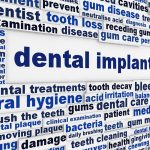
Autogenous bone grafts have been used for some time to augment bone for the placement of dental implants. Recently autogenous dentine graft acquired from extracted teeth showing no sign of infection has been proposed as a potential alternative and a number of studies have suggested favourable outcomes.
The aim of this review was to assess whether the autogenous dentine graft (ADG) shows comparable results and similar clinical performance to other graft materials when utilized for implant placement.
Methods
A protocol for the review was registered with PROSPERO. Searches were conducted in the Cochrane Central Register of Controlled Trials (CENTRAL), PubMed/Medline, Scopus and Web of Science. Pro- and retrospective studies of bone augmentation using autogenous dentine graft in humans involving a control group and implant placement were considered. Two reviewers independently selected studies extracted data and assessed risk of bias. The Cochrane risk-of-bias tool (RoB 2) was used for randomised controlled trials (RCTs) and the Risk of Bias in Non-randomized Studies of Interventions (ROBINS-I) tool for non-randomised studies. The primary outcomes were implant stability (ISQ)and peri-implant marginal bone loss (MBL) (primary outcomes), secondary outcomes included implant-related complications and failure.
Results
- 9 studies (5 RCTs, one controlled clinical trial [CCT] and 3 retrospective studies) were included
- Studies were published between 2014 and 2021.
- Implant placement was immediate in 2 studies, delayed in 4 and simultaneous with grafting in 3 studies.
- Overall implant survival rate was 97.37% for the ADG group and 97.30% for the bone grafted group.
- One of the 6 RCTs/CCTs was at low risk of bias, one at high risk and 4 had some concerns.
- Two of the retrospective studies were considered to be at serious risk of bias and one was at moderate risk.
- 5 RCTs contributed to the meta-analyses, no significant differences were found between ADG and bone grafts (see table below)
| Outcomes | No of studies | Mean difference (MD) or Standard mean difference (SMD) [95%CI] |
| Primary implant stability | 3 | MD = −0.74 (−3.36 to 1.88) |
| Secondary implant stability | 3 | MD = −1.29 (−5.69 to 3.11) |
| Marginal bone loss- 6 months | 2 | SMD = −0.26 ( −0.64 to 0.12) |
| Marginal bone loss- 18 months | 2 | SMD = −0.12 (−0.50 to 0.26) |
Conclusions
The authors concluded: –
autogenous dentine graft is an effective option for bone augmentation around dental implants, with acceptable implant stability, marginal bone loss, and incidences of complications and failure.
Comments
The authors have registered their protocol on PROSPERO and searched a good range of databases. As might be expected for a new technique only a small number of small studies were identified. Five of the 9 included studies were RCTs however only one of this was considered to be at low risk of bias. The authors noted a number of complication in the ADG group including peri-implant mucositis, haematoma, membrane exposure, and wound dehiscence but not provide information on number or mention any complications in the bone graft group. The maximum follow-up period was only 18 months, and one implant failure was noted on each of the ADG and bone graft groups. Overall, the findings suggest that in the short-term outcomes were similar for both ADG and bone graft groups were similar. However, only a small number of limited quality small studies were available and contributed to the outcomes analysis. In addition, a range of different implant procedures was investigated so the findings should be interpreted cautiously. Additional well conducted and reported prospective studies of appropriate size and follow-up are needed to confirm and clarify the finding sin relation to ADG.
Links
Primary Paper
Mahardawi B, Jiaranuchart S, Tompkins KA, Pimkhaokham A. Efficacy of the autogenous dentin graft for implant placement: a systematic review and meta-analysis of randomized controlled trials. Int J Oral Maxillofac Surg. 2022 Oct 31:S0901-5027(22)00446-5. doi: 10.1016/j.ijom.2022.10.014. Epub ahead of print. PMID: 36328864.
